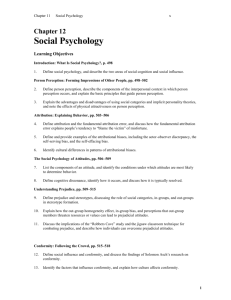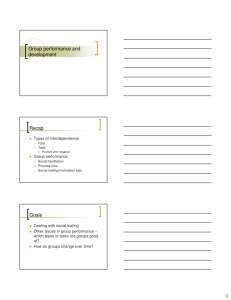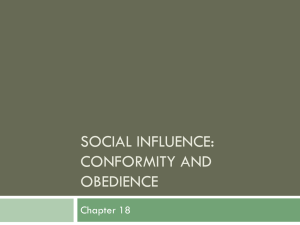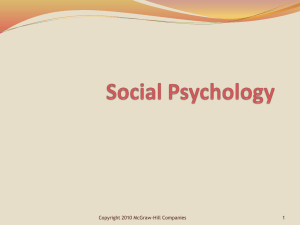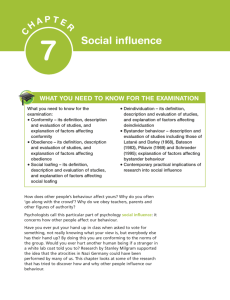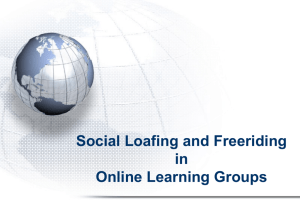Lesson on Social Influence
advertisement
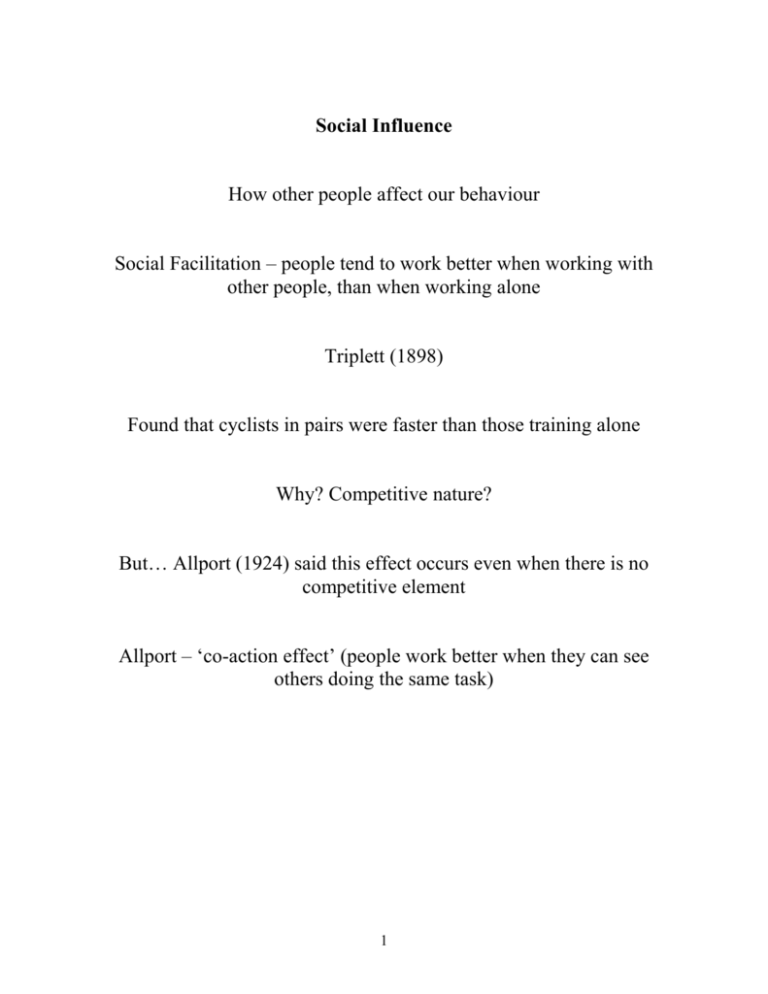
Social Influence How other people affect our behaviour Social Facilitation – people tend to work better when working with other people, than when working alone Triplett (1898) Found that cyclists in pairs were faster than those training alone Why? Competitive nature? But… Allport (1924) said this effect occurs even when there is no competitive element Allport – ‘co-action effect’ (people work better when they can see others doing the same task) 1 Social Facilitation in everyday life Social facilitation can be used to improve people’s performance e.g. children at school Audience effects = a person’s performance may also be affected by someone watching This is called ‘audience effect’ Participants doing an easy task perform better when there’s an audience Michaels et al (1982) = looked at the ability of pool players = researchers stood by the table = …above average players = increased from 71% to 80% (increase arousal) … below average players = decreased from 36% to 25% (arousal overload) ??? 2 conclusions: audience improves performance of well learned skills but damages the performance of poorly learned skills Audience effects in real life Improvements in performance has been seen in employment Hawthorne effect = research on factory workers = productivity increased when watched (even when conditions were made worse) Due to audience effect? Social Loafing When working in a group – each person tends to reduce their personal effort This is called the ‘Ringelmann effect’ (Max Ringelmann, 1913) He measured the amount of effort men put into a tug of war task The greater the number of men pulling the less each man pulled 3 This is also called ‘social loafing’ = Latane (1979) asked participants to shout and clap (sometimes alone/sometimes with others) They wore headsets and the amount of noise was recorded Results = the larger the group, the less effort each person made Conclusion = people made less effort in groups because others were contributing Social Loafing in everyday life Work, education and sport etc provide opportunities for social loafing To avoid social loafing in team sports, coaches provide feedback both to individuals and to the team as a whole In education – when students work in groups on a piece of work – teachers are encouraged to identify the effort that each members offers Social loafing is mainly a western phenomenon In other collectivist cultures, the opposite happens – ‘social striving’ 4 Why? In collectivist cultures, individual goals are NOT as important as team goals Bystander Behaviour Bystander behaviour – how people behaviour in an emergency Darley and Latane (1968) – interested in seeing hwat people would do in an emergency which others also knew about = asked participants to discuss a topic with some people close by They were told this was to be via an intercom so as to reduce embarrassment during the discussion There were 3 conditions – 1. participants thought there was only 1 other person in discussion 2. thought there were 2 others 3. thought there were 5 others 5 early in the discussion – one of the others mentioned he sometimes had seizures later in discussion – he had a seizure how did participants react? Found = the more ‘others’ present, the less likely any one person is to help (diffusion of responsibility) Imitating Others If someone else goes to help, does that encourage others to follow their example? Bryan and Test (1967) – arranged for a woman (confederate) to stand beside a car with a flat tyre (test condition) A helping situation (experimental condition) was set up quarter of a mile before the car with the flat tyre In this condition – a woman stood beside a car watching a man change the tyre (he was the model) Results = more cars stopped to help when they had seen the helping situation 6 Conclusion = people are more likely to help others when they have seen someone else model helping behaviour Conformity In real life we adjust our actions and opinions to fit with others – ‘yielding to the perceived pressure of group members, even though no one tells us to’ Philip Zimbardo carried out a conformity study called ‘Stanford Prison Experiment’ (watch video) 7 Lesson on Social Influence What you will need to know for the exam 1. studies which demonstrate the effect of other people a. social facilitation b. social loafing c. audience effects d. bystander behaviour 2. definitions of OBEDIENCE, CONFORMITY AND DE-INDIVIDUATION 3. studies of obedience, conformity and de-individuation 4. evaluation of studies 5. factors which affect obedience, conformity and deinidividuation 6. sources of social influence a. group norms b. internal filters (e.g. scripts) c. external filters (e.g. media) During today’s lesson, fill-in the blanks spaces with the appropriate definitions of the key terms relating to Social Influence. Conformity Social Influence -------------------------------------------------------------------------------------------------------------------------------------------------------------Social facilitation -------------------------------------------------------------------------------------------------------------------------------------------------------------Social loafing -------------------------------------------------------------------------------------------------------------------------------------------------------------- 8 Audience effects -------------------------------------------------------------------------------------------------------------------------------------------------------------- Bystander behaviour-----------------------------------------------------------------------------------------------------------------------------------------------------------Conformity -------------------------------------------------------------------------------------------------------------------------------------------------------------Social norms -------------------------------------------------------------------------------------------------------------------------------------------------------------Informational Social influence -------------------------------------------------------------------------------------------------------------------------------------------------------------Normative Social influence -------------------------------------------------------------------------------------------------------------------------------------------------------------Public compliance -------------------------------------------------------------------------------------------------------------------------------------------------------------Private acceptance-------------------------------------------------------------------------------------------------------------------------------------------------------------Personal norm -------------------------------------------------------------------------------------------------------------------------------------------------------------- 9 Studies of Conformity Stanford Prison Experiment ----------------------------------------------------------------------------------------------------------------------------------------------------------------------------------------------------------------------------------------------------------------------------------------------------------------------------------------------------------------------------------------------------------------------------------------------------------Evaluation of Stanford Prison Experiment ----------------------------------------------------------------------------------------------------------------------------------------------------------------------------------------------------------------------------------------------------------------------------------------------------------------------------------------------------------------------------------------------------------------------------------------------------------SherifAutokinetic Effect ------------------------------------------------------------------------------------------------------------------------------------------------------------------------------------------------------------------------------------------------------------------------------------------------------------------------------------------------------------------------------------------------------------------------------------------------------------------------------------------------------------------------- 10 Solomon Asch -------------------------------------------------------------------------------------------------------------------------------------------------------------------------------------------------------------------------------------------------------------------------------------------------------------------------------------------------------------------------------------------------------------------------------------------------------------------------------------------------------------------Crutchfield -------------------------------------------------------------------------------------------------------------------------------------------------------------------------------------------------------------------------------------------------------------------------------------------------------------------------------------------------------------------------------------------------------------------------------------------------------------------------------------------------------------------- Factors Affecting Conformity Group identification------------------------------------------------------------------------------------------------------------------------------------------------------------Group size -------------------------------------------------------------------------------------------------------------------------------------------------------------Social support -------------------------------------------------------------------------------------------------------------------------------------------------------------- 11 Personality -------------------------------------------------------------------------------------------------------------------------------------------------------------Gender -------------------------------------------------------------------------------------------------------------------------------------------------------------Culture -------------------------------------------------------------------------------------------------------------------------------------------------------------Social roles -------------------------------------------------------------------------------------------------------------------------------------------------------------- Obedience Obedience -------------------------------------------------------------------------------------------------------------------------------------------------------------Legitimate Authority -------------------------------------------------------------------------------------------------------------------------------------------------------------Coercion -------------------------------------------------------------------------------------------------------------------------------------------------------------Authoritarian Personality -------------------------------------------------------------------------------------------------------------------------------------------------------------- 12 Displacement -------------------------------------------------------------------------------------------------------------------------------------------------------------Studies of Obedience Milgram -------------------------------------------------------------------------------------------------------------------------------------------------------------------------------------------------------------------------------------------------------------------------------------------------------------------------------------------------------------------------------------------------------------------------------------------------------------------------------------------------------------------Evaluation of Milgram ------------------------------------------------------------------------------------------------------------------------------------------------------------------------------------------------------------------------------------------------------------------------------------------------------------------------------------------------------------------------------------------------------------------------------------------------------------------------------------------------------------------------Internal Validity ------------------------------------------------------------------------------------------------------------------------------------------------------------------External Validity ------------------------------------------------------------------------------------------------------------------------------------------------------------------- 13 Factors Affecting Obedience Proximity of Victim -------------------------------------------------------------------------------------------------------------------------------------------------------------Proximity of Experimenter -------------------------------------------------------------------------------------------------------------------------------------------------------------Perceived authority------------------------------------------------------------------------------------------------------------------------------------------------------------Social support -------------------------------------------------------------------------------------------------------------------------------------------------------------Individual differences----------------------------------------------------------------------------------------------------------------------------------------------------------Dress of person Giving the order -------------------------------------------------------------------------------------------------------------------------------------------------------------Title of person Giving the order -------------------------------------------------------------------------------------------------------------------------------------------------------------- 14 Agentic state -------------------------------------------------------------------------------------------------------------------------------------------------------------Victim Derogation -------------------------------------------------------------------------------------------------------------------------------------------------------------Cognitive Dissonance -------------------------------------------------------------------------------------------------------------------------------------------------------------Dehumanization -------------------------------------------------------------------------------------------------------------------------------------------------------------- De-individuation De-individuation -------------------------------------------------------------------------------------------------------------------------------------------------------------Hood Experiment -------------------------------------------------------------------------------------------------------------------------------------------------------------------------------------------------------------------------------------------------------------------------------------------------------------------------------------------------------------------------------------------------------------------------------------------------------------------------------------------------------------------- 15 Evaluation Of Hood Experiment -------------------------------------------------------------------------------------------------------------------------------------------------------------------------------------------------------------------------------------------------------------------------------------------------------------------------------------------------------------------------------------------------------------------------------------------------------------------------------------------------------------------- Summary Obedience Conformity 16 ACTIVITY 1: Normative and Informational Influence (Item A) Elaine, Ingrid, Pauline and Mary-Anne were enjoying a drink in the clubhouse after a round of golf. Elaine was telling the others a story. She had been asked by a neighbour if she could arrange a game of golf for a 15 year old boy from Finland who was in England on holiday. She asked John, the young assistant professional, to play with him. ‘Do you know,’ Elaine said, ‘I got the shock of my life. The boy from Finland was black and my neighbour hadn’t even told me. So I went to John and apologised. Not that I’ve got anything against blacks,’ she added. The other women nodded and murmured agreement. However, Mary-Anne, who recounted this story later, was taken aback. ‘I was disgusted with Elaine’s attitude,’ she said. ‘But I was even more disgusted with myself. I had given Elaine every indication that I was in complete agreement with her.’ Q Is Mary_Anne’s behaviour an example of normative social influence or informational social influence? Q Is it an example of public compliance or private acceptance? Give reasons for your answers. 17 ACTIVITY 2: Summary of main theorists of Social Influence Using the blank sheet(s) provided, draw a summary poster of the four main theorists of Social Influence: Asch, Sherif, Zimbardo and Milgram. Include the following, for example: Name of theorist Date of study Title of study Methodology Findings Criticisms of study Whether they relate to Conformity or Obedience 18

